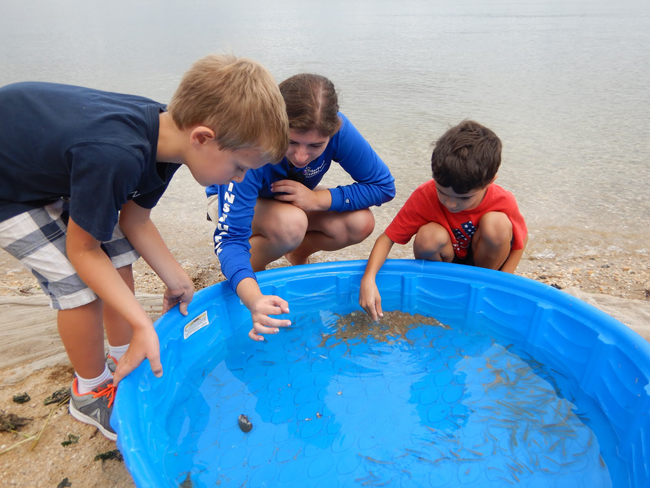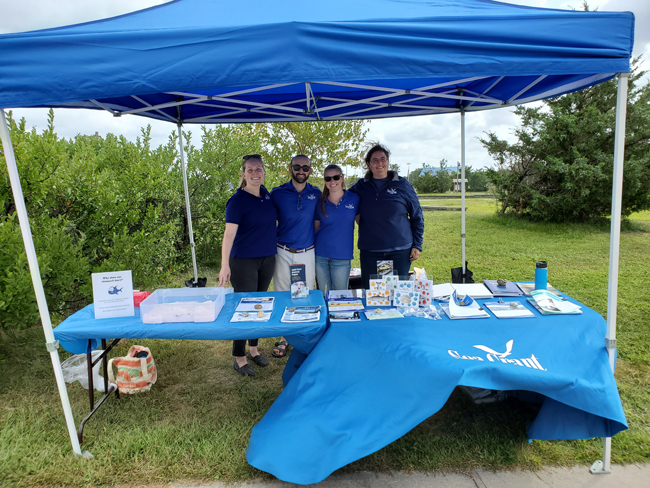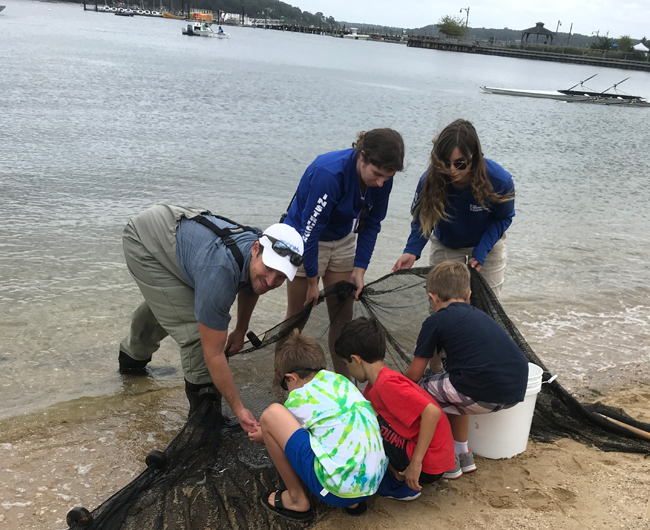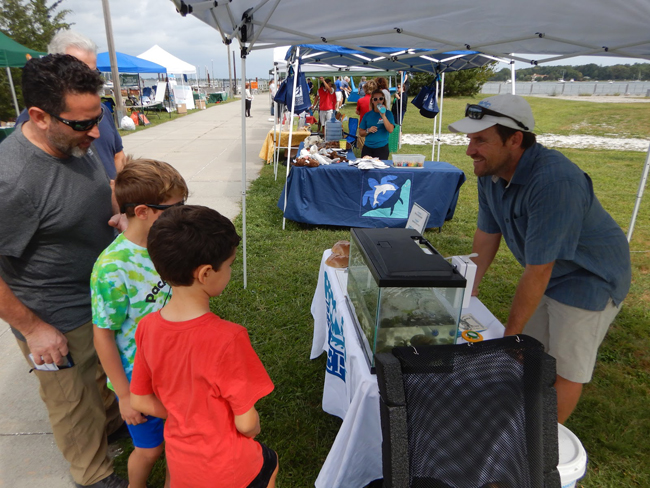
Credit: NYSDEC.
Contacts:
Jimena Perez-Viscasillas, Long Island Sound Study Outreach Coordinator, E: jbp255@cornell.edu, P: (631) 632-8730
Michael Ciaramella, Seafood Specialist, NYSG, E: mc2544@cornell.edu, P: (631) 632-8730
Stony Brook, NY, October 16, 2019 - An estuary is a partially enclosed body of water where fresh water from rivers mixes with salt water from the ocean. Estuaries are important for a number of reasons: they're home to unique plant and animal communities adapted to brackish water, they’re among the most productive ecosystems in the world, and many animals rely on estuaries for food, places to breed and migration stopovers. With more than 23 million people living within 50 miles of the Long Island Sound, this urban estuary is particularly sensitive to human impact.
To educate and celebrate the three estuaries of Long Island (The Long Island Sound, Peconic Estuary, and the South Shore Estuary), the Long Island Sound Study (LISS), Peconic Estuary Program (PEP), and South Shore Estuary Reserve (SSER), in partnership with The WaterFront Center and Friends of the Bay, hosted Estuary Day in Oyster Bay, New York, kicking off National Estuary Week.

Credit: NYSDEC.
Residents and families from around Long Island gathered on Saturday, September 14th for the second annual celebration of Long Island’s estuaries. New York State Senator of the 5th District, James Gaughran, was also in attendance, participating in the beach clean-up and informational sessions.
This year’s theme was marine debris and microplastics. The celebration provided a great opportunity for attendees and organizations to learn about sources of debris and microplastics that make their way into New York’s estuaries.

In addition to NYSG's Director, Becky Shuford (not pictured), a number of NYSG specialists were in attendance at this year's Estuary Day, including: (l-r) Krista Stegemann, NYSG Ocean & Marine Outreach Coordinator; Michael Ciaramella, NYSG’s Seafood Specialist; Kathleen Fallon, NYSG's Coastal Processes and Hazards Specialist; and Jimena Perez-Viscasillas, NYSG's LISS Outreach Coordinator. Credit: Becky Shuford/NYSG.
“Based on what we’ve seen, people seem to be aware of microplastics to some degree, and of marine pollution caused by plastic bottles and bags ,” said Jimena Perez-Viscasillas, NYSG's LISS Outreach Coordinator. “But few people seem to know that the most significant source of marine debris found in beach clean-ups is cigarette butts, which actually contain plastic in them.” Perez-Viscasillas, assisted with planning and tabled at the event sharing information on current issues facing the Long Island Sound to event attendees, along with Michael Ciaramella, NYSG’s Seafood Specialist.
True to the theme, the 2019 Estuary Day celebration kicked off with a clean-up of Beekman Beach on Oyster Bay. Trash on the beach was sorted by plastics and non-plastics, and suitable plastic pieces were collected for re-use as arts-and-crafts material for kids. Other festivities included a seining activity, using nets to introduce kids to the animals inhabiting estuarine ecosystems. Later in the day, attendees had opportunities to go beach-combing and birding, as well as paddleboard, kayak, and sail around Oyster Bay.

Credit: Mike Ciaramella/NYSG.
A series of 20 minute lectures with 10-minute Q&A sessions were presented at the WaterFront Center. Citizens Campaign for the Environment presented “Reducing Plastics in NY,” the Atlantic Marine Conservation Society shared information on the impacts of marine debris on wildlife like marine mammals and sea turtles, and the United States Geological Survey shared their methods on sampling for microplastics.

Credit: NYSDEC.
Several other environmental organizations pitched in to educate and prevent debris and microplastic pollution. The Coalition to Save Hempstead harbor provided a craft and photo project utilizing collected marine debris, and the Manhasset Bay Protection Committee led activities with a watershed model and a reusable bag coloring activity.
Estuary Day is an ongoing effort partnership among Long Island’s three estuary programs.
Partners include:
Long Island Sound Study
Friends of The Bay
New York Department of State
Peconic Baykeeper
North Shore Land Alliance Inc.
American Littoral Society Coastal Conservation
Audubon New York
Coalition to Save Hempstead harbor
The WaterFront Center
Theodore Roosevelt Sanctuary and Audubon Center
Group for the East End
Manhasset Bay Protection Committee
Next year, the Peconic Estuary Program is slated to host the third annual Estuary Day celebration.
More Info: Long Island Sound Study
Long Island Sound is one of the 28 nationally-designated estuaries under
the NEP, which was established by Congress in 1987 to improve the
quality of Long Island Sound and other places where rivers meet the sea.
The Long Island Sound Study, conducted under the Environmental
Protection Agency’s (EPA) National Estuary Program (NEP), is a
cooperative effort between the EPA and the states of Connecticut and New
York to restore and protect the Sound and its ecosystems.
For more on what you can do to make a difference, click over to the "Get Involved" or "Stewardship" sections of the Long Island Sound Study's Web site. News on the Long Island Sound Study can also be found in New York Sea Grant's related archives.
If you would like to receive Long Island Sound Study's newsletter, please visit their site's homepage and sign up for the "e-news/print newsletter" under the "Stay Connected" box.
For daily updates and tips on how you can help protect and restore Long Island Sound, please join LISS on Facebook, Twitter or, sign up for their RSS feeds.
More Info: New York Sea Grant
New York Sea Grant (NYSG), a cooperative program of Cornell University
and the State University of New York (SUNY), is one of 33 university-based
programs under the National Oceanic and Atmospheric Administration’s
National Sea Grant College Program.
Since 1971, NYSG has represented a statewide network of integrated
research, education and extension services promoting coastal community
economic vitality, environmental sustainability and citizen awareness
and understanding about the State’s marine and Great Lakes resources.
Through NYSG’s efforts, the combined talents of university scientists
and extension specialists help develop and transfer science-based
information to many coastal user groups—businesses and industries,
federal, state and local government decision-makers and agency managers,
educators, the media and the interested public.
The program maintains Great Lakes offices at Cornell University, SUNY
Buffalo, SUNY Oswego and the Wayne County Cooperative Extension office
in Newark. In the State's marine waters, NYSG has offices at Stony Brook
University in Long Island, Brooklyn College and Cornell Cooperative
Extension in NYC and Kingston in the Hudson Valley.
For updates on Sea Grant activities: www.nyseagrant.org has RSS, Facebook, Twitter, and YouTube links. NYSG offers a free e-list sign up via www.nyseagrant.org/nycoastlines for its flagship publication, NY Coastlines/Currents, which is published quarterly. Our program also produces an occasional e-newsletter,"NOAA Sea Grant's Social Media Review," via its blog, www.nyseagrant.org/blog.